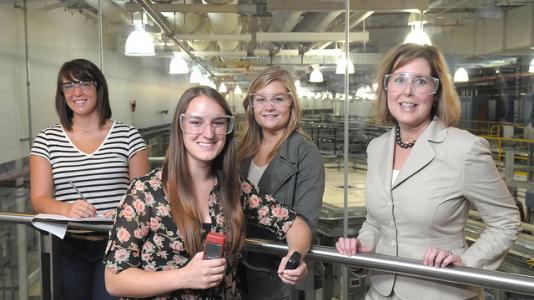
A team from Oklahoma State University (OSU) spent their summer working at the U.S. Department of Energy’s (DOE) Argonne National Laboratory, performing a lighting survey as part of Argonne’s sustainability program, which aims to reduce the laboratory’s energy consumption by 30 percent by 2015.
The students, Anna Eckhoff, Ashlee Dowdy and Kristin Schieffer, are working with Professor Paulette Hebert, Ph.D., as part of the DOE/National Science Foundation-funded Faculty and Student Teams (FaST) program. The program provides hands-on research opportunities for faculty and students from colleges and universities with limited research facilities and those institutions serving populations underrepresented in the fields of science, engineering and technology.
“There is no better way to learn real-world constraints that do not always exist in the classroom,” said Eckhoff. The team was surprised to find that a de-lamping strategy was actually a better fit in some of the labs than newer light-emitting diode (LED) technology.
“After this project, I am much more aware of the challenges of retrofitting existing workspaces,” said Dowdy. The team worked together making empirical measurements and using several software tools to conduct their survey and make cost-effective and energy-efficient recommendations.
“The experience is invaluable and provided many cross-training and collaboration opportunities,” added team member Kristin Schieffer.
College students and mentors from several schools across the country spent 10 weeks this summer doing hands-on research projects at Argonne as part of the FaST program. The typical team comprises one faculty member and 2 or 3 undergraduate students.
“It is an honor to be a part of this program,” said Hebert. “These young women work very hard, they learn from each other and I learn from them too.” This is the second all female team that she has mentored as part of the FaST program at Argonne.
“Being a part of Argonne’s sustainability team provides a real-world experience that gives them a chance to see how their contributions can make a difference and all kinds of different careers paths that exist,” she added.
All of the FaST teams will share their findings with each other and Argonne representatives on Wednesday, Aug. 3, 2011. The FaST program provides a continuous learning experience that includes submitting research for publication, developing materials to participate in poster sessions and applying for grants.
This year, the FaST program at Argonne consists of nine different teams representing a wide array of research areas and institutions:
Chicago State University—Dr. Kristy Mardis and her students Seri Kamari, Adam Zayed and Brian Banks are investigating solar fuels production through electronic structure calculations and molecular dynamics simulations of catalysts.
Chicago State University—Dr. Jesse Wang and his students Edward Nash and Alexander Stovall will work on the loop-less code generator and AMD 64 based computer systems and are also working with Argonne scientists to improve the performance of Argonne’s Blue Gene/P supercomputer and develop custom codes and scripts as well as possible search techniques.
Governor’s State University—Dr. Soon-Ok Park and her students Billy Jackson, Anthony Stulgate and Gregory White will implement the use .NET technology to increase the efficiency and analysis capabilities of protein expression data collected at the Midwest Center for Structural Genomics.
Governor’s State University—Dr. Clare Tang and her students David Concha, Caroline Reels and Sofia Galarza are building interfaces for automatic data transfer from environmental field investigations and monitoring of contaminated sites as well as simulating various biofuel feedstock scenarios.
Northern New Mexico College —Dr. Ulises Ricoy and his students Jamie Garcia and Matthew Medina are using peptide structures to create nanoarchitectures for electronic materials, solar cells and nanobiomedicine.
Oklahoma State University—Dr. Paulette Hebert and her students Anna Eckhoff, Ashlee Dowdy and Kristin Schieffer are working on Argonne’s sustainability program by conducting a lighting survey to find opportunities for energy and cost savings.
University of Puerto Rico-Mayaguez—Dr. Yi Jia and his students Dennis Negron, Miguel Rosado Martinez and Michael Rodriquez Martinez are working to address power consumption and hardware failure in supercomputing environments by designing and deploying an environmental sensor system.
University of Puerto Rico-Mayaguez —Dr. Eduardo Ortiz-Rivera and his students Carlos Torres-Casiano, Maria Gonzalez-Pardo and Edmarie Arce Febles are developing new methodologies for forecasting renewable resources and power output in the Midwest.
University of Texas-Pan American - Dr. Mark Cunningham and his students Jorge Salazar, Jennifer Morales and Ike Muniez are studying structural genomics and protein characterization using X-ray crystallography and computational approaches.